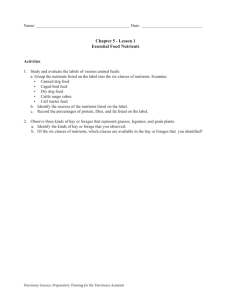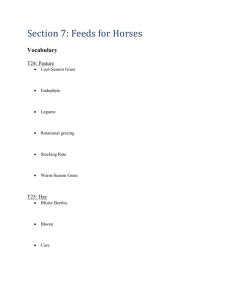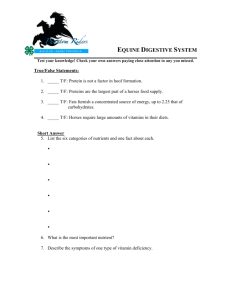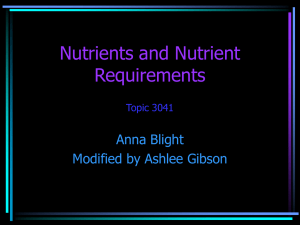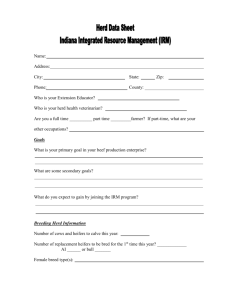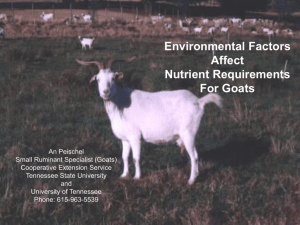Crops to Qrow for THE DAIRY COWS
advertisement
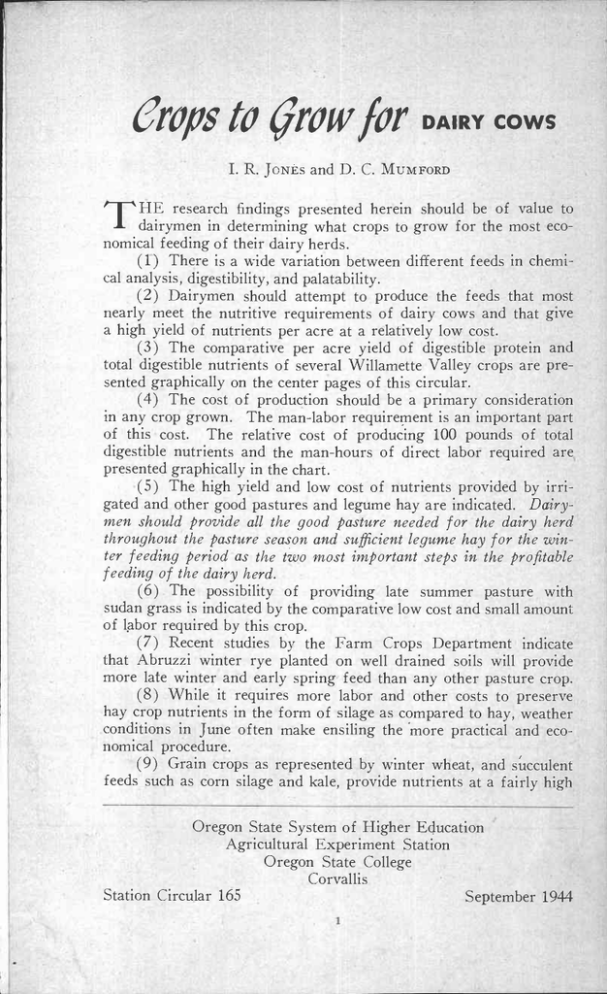
Crops to Qrow for I. R. JONES DAIRY COWS and D. C. MUMFORD research findings presented herein should be of value to THE dairymen in determining what crops to grow for the most economical feeding of their dairy herds. (1)There is a wide variation between different feeds in chemical analysis, digestibility, and palatability. Dairymen should attempt to produce the feeds that most nearly meet the nutritive requirements of dairy cows and that give a high yield of nutrients per acre at a relatively low cost. The comparative per acre yield of digestible protein and total digestible nutrients of several Willamette Valley crops are presented graphically on the center pages of this circular. The cost of production should be a primary consideration in any crop grown. The man-labor requirement is an important part of this cost. The relative cost of producing 100 pounds of total digestible nutrients and the man-hours of direct labor required are presented graphically in the chart. The high yield and low cost of nutrients provided by irrigated and other good pastures and legume hay are indicated. Dairy- men should provide all the good pasture needed for the dairy herd throughout the pasture season and sufficient legume hay for the winter feeding period as the two most important steps in the profitable feeding of the dairy herd. The possibility of providing late summer pasture with sudan grass is indicated by the comparative low cost and small amount of labor required by this crop. Recent studies by the Farm Crops Department indicate that Abruzzi winter rye planted on well drained soils will provide more late winter and early spring feed than any other pasture crop. While it requires more labor and other costs to preserve hay crop nutrients in the form of silage as compared to hay, weather conditions in June often make ensiling the more practical and economical procedure. Grain crops as represented by winter wheat, and succulent feeds such as corn silage and kale, provide nutrients at a fairly high Oregon State System of Higher Education Agricultural Experiment Station Oregon State College Corvallis Station Circular 165 September 1944 COMPARATIVE PER ACRE YIELD OF TOTAL DIGESTIBLE NUTRIENTS AND DIGESTIBLE PROTEIN IN SELECTED CROPS; ALSO RELATIVE COST AND MAN HOURS DIRECT LABOR TO PRODUCE 100 POUNDS TOTAL DIGESTIBLE NUTRIENTS YIELD PER ACRE TO PRODUCE 100 POUNDS T.D.N CROPS RELATIVE COST (WILLAMETTE VALLEY TOTAL DIGESTIBLE NUTRIENTS 1 DIGESTIBLE PROTEIN I HOURS LABOR NATIVE GRASS PASTURE TAME MIXED GRASS PASTURE WHEAT (GRAIN) SUDAN GRASS PASTURE sw. RED a ALSIKE CLOVER PASTURE RED CLOVER HAY I CORN SILAGE VETCH a OAT HAY '*& KALE £è VETCH a OAT SILAGE REED CANARY GRASS PASTURE ALFALFA HAY IRRIGATED LADINO CLOVER a GRASS PASTURE 4200 3600 2700 POUNDS 1800 900 0 0 10 20 30 40 50 60 70 80 90 100 0 PER CENT PREPARED BY O.S.C. DAIRY HUSBANDRY AND FARM MANAGEMENT DEPARTMENTS- APRIL 1944 2 I HOURS * Total Digestible Nutrients cost although oth.er considerations may justify their production. The labor requirements for grain crops are relatively low. For kale, although high, the labor costs are quite well distributed throughout the year. (10) Total digestible nutrients can be produced in pasture and hay for one-fourth to one-half the cost of the nutrients in farm grains or mill feeds. Digestible protein can be produced in pasture or legume hay more cheaply than it can be purchased even in the high protein concentrates, which may not always be available. The relative amount of digestible protein compared to the total amount of other digestible nutrients (starches, fiber, fat, etc.) in feeds is known as the nutritive ratio. Average milk cows require about 1 pound of digestible protein for each 7 pounds of other digestible nutrients or a ration with a nutritive ratio of about 1 to 7. The nutritive ratios of different types of feeds are indicated by the following examples: Nutritive ratio Soybean meal Wheat mixed feed (mill run) Alfalfa hay Irrigated ladino clover and grass pasture Vetch and oat hay Wheat to 4.4 to 4.4 . to .5.0 to 7.4 to 8.8 Ryegrass hay Corn silage - Oat straw to 1.2 to 11.4 to 13.4 to 48.0 ... (13) Good pastures and legume hays provide ample protein for milk production. Production on these feeds, however, is limited to about 1 pound of butterfat daily because cows have a limit in their capacity to eat the high fiber and high water containing feeds. The farm grains with or without wheat mixed feed (mill run) provide the needed total digestible nutrients for high production when fed with good pasture or legume hays. If roughages with a wide nutritive ratio such as ryegrass ha and corn silage are fed, it is necessary to add to the grain mixture 20 to 25 per cent of a high protein concentrate such as soybean meal in order to provide the cow with a ration having a nutritive ratio of about 1 to 7. Noigs: ()rcgon Agricultural Experinient Station Bulklin 398. available on request. presents the feedtng values of most feeds and the nutritive requirements of dairy cows for It is recognized that sonic of the cropa indicated will not grow or do well on all soil types; and that yields per acre will show wide variations on different farms because of the soil type, present state of fertility, or lack of moisture. Cost data have been calculated on a comparative basis by the Department of Farm maintenance and for milk and butterfat production. Management, Oregon Agricultural Experiment Station. 4
